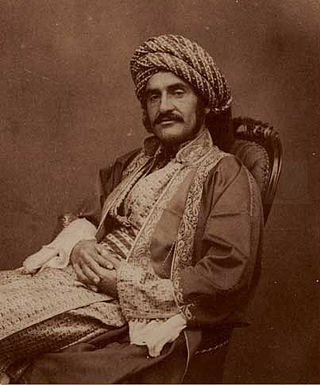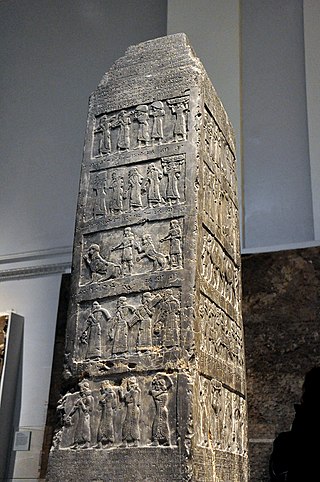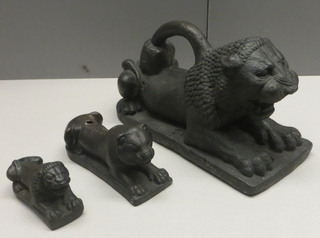This article needs additional citations for verification .(April 2012) |
| |||
|---|---|---|---|
| +... | |||
Below are notable events in archaeology that occurred in 1845.
This article needs additional citations for verification .(April 2012) |
| |||
|---|---|---|---|
| +... | |||
Below are notable events in archaeology that occurred in 1845.

Shalmaneser III was king of the Neo-Assyrian Empire from 859 BC to 824 BC.

Sir Austen Henry Layard was an English Assyriologist, traveller, cuneiformist, art historian, draughtsman, collector, politician and diplomat. He was born to a mostly English family in Paris and largely raised in Italy. He is best known as the excavator of Nimrud and of Nineveh, where he uncovered a large proportion of the Assyrian palace reliefs known, and in 1851 the library of Ashurbanipal. Most of his finds are now in the British Museum. He made a large amount of money from his best-selling accounts of his excavations.

Hormuzd Rassam was an Assyriologist and author. He is known for making a number of important archaeological discoveries from 1877 to 1882, including the clay tablets that contained the Epic of Gilgamesh, the world's oldest notable literature. He is widely believed to be the first-known Middle Eastern and Assyrian archaeologist from the Ottoman empire. He emigrated to the United Kingdom, where he was naturalized as a British citizen, settling in Brighton. He represented the government as a diplomat, helping to free British diplomats from captivity in Ethiopia.

Nimrud is an ancient Assyrian city located in Iraq, 30 kilometres (20 mi) south of the city of Mosul, and 5 kilometres (3 mi) south of the village of Selamiyah, in the Nineveh Plains in Upper Mesopotamia. It was a major Assyrian city between approximately 1350 BC and 610 BC. The city is located in a strategic position 10 kilometres (6 mi) north of the point that the river Tigris meets its tributary the Great Zab. The city covered an area of 360 hectares. The ruins of the city were found within one kilometre (1,100 yd) of the modern-day Assyrian village of Noomanea in Nineveh Governorate, Iraq.

The Black Obelisk of Shalmaneser III is a black limestone Neo-Assyrian sculpture with many scenes in bas-relief and inscriptions. It comes from Nimrud, in northern Iraq, and commemorates the deeds of King Shalmaneser III. It is on display at the British Museum in London, and several other museums have cast replicas.

Dur-Sharrukin, present day Khorsabad, was the Assyrian capital in the time of Sargon II of Assyria. Khorsabad is a village in northern Iraq, 15 km northeast of Mosul. The great city was entirely built in the decade preceding 706 BC. After the unexpected death of Sargon in battle, the capital was shifted 20 km south to Nineveh.

Ashur-nasir-pal II was the third king of the Neo-Assyrian Empire from 883 to 859 BC. Ashurnasirpal II succeeded his father, Tukulti-Ninurta II. His son and successor was Shalmaneser III and his queen was Mullissu-mukannišat-Ninua.
Archaeology is the study of human activity in the past, primarily through the recovery and analysis of the material culture and environmental data that they have left behind, which includes artifacts, architecture, biofacts and cultural landscapes.
Below are notable events in archaeology that occurred in 1888.
Below are notable events in archaeology that occurred in 1894.
The year 1817 in archaeology involved some significant events.

Ashteroth Karnaim, also rendered as Ashtaroth Karnaim, was a city in Bashan east of the Jordan River.

Sir Max Edgar Lucien Mallowan, was a prominent British archaeologist and academic, specializing in the Ancient Near East. Having studied classics at Oxford University, he was trained for archaeology by Leonard Woolley at Ur and Reginald Campbell Thompson at Nineveh. He then directed a number of archaeological expeditions sponsored by the British Museum and the British School of Archaeology in Iraq. He was the second husband of Agatha Christie, having met her during the excavation at Ur in 1930. He served in the Royal Air Force Volunteer Reserve during the Second World War, and then entered academia. He was Professor of Western Asiatic Archaeology at the University of London (1947–1962) and a fellow of All Souls College, Oxford (1962–1971).

The Nimrud lens, also called Layard lens, is an 8th-century BC piece of rock crystal which was unearthed in 1850 by Austen Henry Layard at the Assyrian palace of Nimrud in modern-day Iraq. It may have been used as a magnifying glass or as a burning-glass to start fires by concentrating sunlight, or it may have been a piece of decorative inlay.

Lucy Myers Wright Mitchell was an American classical archaeologist, historian, and missionary who studied ancient art. Mitchell was the first American to publish a book on classical sculpture and was one of the first women to study the field of classical archaeology.

The Nimrud Slab, also known as the Calah Orthostat Slab, is the top half of a "summary inscription" of the reign of Adad-nirari III discovered in 1854 by William Loftus in his excavations at Nimrud on behalf of the Assyrian Excavation Fund.

The Stela of Ashurnasirpal II is an enormous Assyrian monolith that was erected during the reign of Ashurnasirpal II. The stela was discovered in the mid nineteenth century at the ancient site of Kalhu by the famous British archaeologist Austen Henry Layard. Dated to between 883-859 BC, the sculpture is now part of the British Museum's collection.

The Assyrian lion weights are a group of bronze statues of lions, discovered in archaeological excavations in or adjacent to ancient Assyria.

Phoenician metal bowls are approximately 90 decorated bowls made in the 7th–8th centuries BCE in bronze, silver and gold, found since the mid-19th century in the Eastern Mediterranean and Iraq. They were historically attributed to the Phoenicians, but are today considered to have been made by a broader group of Levantine peoples.